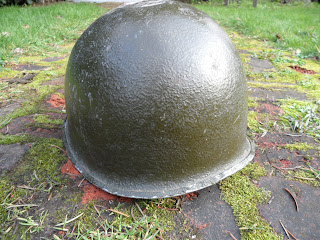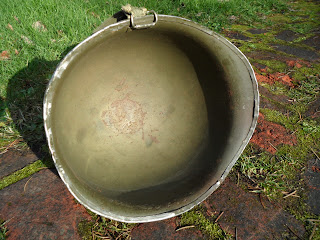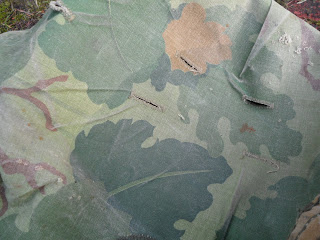1944, US M1 Steel Helmet & 1950's era Liner
This steel helmet is an actual WW2 issued helmet that was manufactured between October of 1943 and October of 1944. This steel helmet has the characteristic front seam on the helmet rim. After October of 1944, the rim was changed from stainless steel to Hadfield Maganese steel and the seam was moved to the back of the helmet. This helmet has swivel bales (one missing) and sewn on chin straps (one missing). The first M1 helmets were produced with fixed chin strap bales, but due to breakages, the design was changed to a swivel bail in October of 1943.
The paint finish is a dark green cork texture with a flat green inside. There is a unit designator painted inside the helmet that I have yet to decipher......... I'm still working on that. If anyone has any insight as to the meaning, please email or leave a comment. Thanks.
Update 4-20-11: It appears that the numbers inside the helmet shell are probably the ID number for the soldier it was issued to. The typical numbering system of the 1940's, was to use the last name initial followed by the the last 4 or so numbers of their serial number. The number in this helmet is most likely this type of identification.
Update 4-20-11: It appears that the numbers inside the helmet shell are probably the ID number for the soldier it was issued to. The typical numbering system of the 1940's, was to use the last name initial followed by the the last 4 or so numbers of their serial number. The number in this helmet is most likely this type of identification.
The helmet liner in this helmet is a a post-WW2, 1950's era liner. There are the remains of some sort of unit emblem on both sides of the liner, that have been painted over at some point. The liner has the low-back neck support strap that was used on the WW2 and Korean War era helmets, however the snap-on adjusting pad-strap is missing. The black studs on either side of the interior liner is where the liner chin strap attaches. The interior webbing is attached with "A" washers. Early WW2 liners had a square washer.
.
The only difference between the WW2 produced liners and the 1950's liner is a small grommeted vent hole on the front, forehead portion of the liner. WW2 liners had them, 1950's vintage did not......... other than that, they are identical. My helmet is set up with the 1950's era liner, which makes it correct for the Korean War.
Production of the original M1 helmets ended in August of 1945 with over 22,000,000 produced. A second production run of about 1,000,000 was produced between 1966 and 1967. No other US manufactured M1 helmets were made after that and they were phased out of service in the 1980's when the new style kevlar helmets were introduced.
Here are a couple of good shots showing this style WW2 helmet in use:
1960's US M1 Steel Helmet and Liner
This second helmet is from the second production run of the M1 helmet, manufactured between 1966 and 1967. This second version of the M1 had a slightly different "steel pot" profile. Most noticeably, the rear of the helmet has been raised to give more clearance for packs, etc. Another change that was made on these 2nd run helmets, was the chin straps. the chin straps were attached with a metal crimp-on clip instead of sewing. The liners also were changed to reflect the new helmet shape and as you will see in the photos, the rear neck strap has been eliminated. In its place, a seperate nape strap was issued that attached at the back and rear-sides of the liner and extended down below the liner to hold the helmet firmly on the head. You can see the attachment points-buckles, in the liner view that follows below. My helmet is missing this strap.
These helmets also had the swivel bail for the chinstrap, and the rim seam has now been moved to the rear of the helmet. This helmet has a sand-finish, olive drab, painted outer surface.
These helmets also had the swivel bail for the chinstrap, and the rim seam has now been moved to the rear of the helmet. This helmet has a sand-finish, olive drab, painted outer surface.
Other than the absence of the neck support strap, the late model liners are essentially the same as the WW2 and 1950's era liners.
This helmet is covered with a canvas, Mitchell Pattern, reversible camo cover. The cover was normally worn with the green foliage side out. The cover has "button-hole" slits all over it to hold natural foliage that was gathered the field.
As a final section on these two helmets, I'd like to present a side-by-side comparison of the two helmets:
 |
| WW2 helmet is on the left, 1960's helmet is on the right. |
Here are a couple of historical shots from the 1960's, during the US-Vietnam War:






























No comments:
Post a Comment